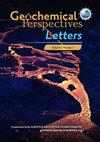Authigenic minerals reflect microbial control on pore waters in a ferruginous analogue
IF 3.7
1区 地球科学
Q1 GEOCHEMISTRY & GEOPHYSICS
引用次数: 0
Abstract
Ferruginous conditions prevailed in the oceans through much of Earth’s history. However, minerals recording these conditions remain difficult to interpret in terms of biogeochemical processes prior to lithification. In Lake Towuti, Indonesia, ferruginous sediments are deposited under anoxic sulfate-poor conditions similar to the Proterozoic oceans, allowing the study of mineralogical (trans)formations during microbial diagenesis.Comprehensive pore water geochemistry, high resolution geochemical core profiles, and electron microscopy of authigenic minerals revealed in situ formation of magnetite, millerite, and abundant siderite and vivianite along a 100 m long sequence. Framboidal magnetites represent primary pelagic precipitates, whereas millerite, a sulfide mineral often overlooked under sulfate-poor conditions, shows acicular aggregates entangled with siderite and vivianite resulting from saturated pore waters and continuous growth during burial. These phases act as biosignatures of microbial iron and sulfate reduction, fermentation and methanogenesis, processes clearly traceable in pore water profiles.
Variability in metal and organic substrates attests to environment driven processes, differentially sustaining microbial processes along the stratigraphy. Geochemical profiles resulting from microbial activity over 200 kyr after deposition provide constraints on the depth and age of mineral formation within ferruginous records.

铁锈色类似物中的自生矿物反映了微生物对孔隙水的控制作用
在地球历史的大部分时间里,海洋中普遍存在铁锈质条件。然而,记录这些条件的矿物仍然难以用岩石化之前的生物地球化学过程来解释。在印度尼西亚的 Towuti 湖,铁屑沉积物是在与新生代海洋类似的缺氧贫硫酸盐条件下沉积的,因此可以研究微生物成岩过程中的矿物(反)形成过程。综合孔隙水地球化学、高分辨率地球化学岩芯剖面以及自生矿物的电子显微镜观察发现,在 100 米长的序列中,磁铁矿、千枚岩以及丰富的菱铁矿和维维安特在原位形成。镜面磁铁矿代表了原生浮游沉淀物,而千枚岩是一种在硫酸盐贫乏条件下经常被忽视的硫化物矿物,它与菱铁矿和维维安岩呈针状集合体缠绕在一起,这是饱和孔隙水和埋藏过程中不断生长的结果。这些阶段是微生物铁和硫酸盐还原、发酵和甲烷生成的生物特征,这些过程在孔隙水剖面中清晰可见。沉积 200 千年后微生物活动产生的地球化学剖面为铁锈岩记录中矿物形成的深度和年龄提供了制约因素。
本文章由计算机程序翻译,如有差异,请以英文原文为准。
求助全文
约1分钟内获得全文
求助全文
来源期刊

Geochemical Perspectives Letters
Earth and Planetary Sciences-Geochemistry and Petrology
CiteScore
7.00
自引率
2.00%
发文量
42
审稿时长
15 weeks
期刊介绍:
Geochemical Perspectives Letters is an open access, internationally peer-reviewed journal of the European Association of Geochemistry (EAG) that publishes short, highest-quality articles spanning geochemical sciences. The journal aims at rapid publication of the most novel research in geochemistry with a focus on outstanding quality, international importance, originality, and stimulating new developments across the vast array of geochemical disciplines.
 求助内容:
求助内容: 应助结果提醒方式:
应助结果提醒方式:


